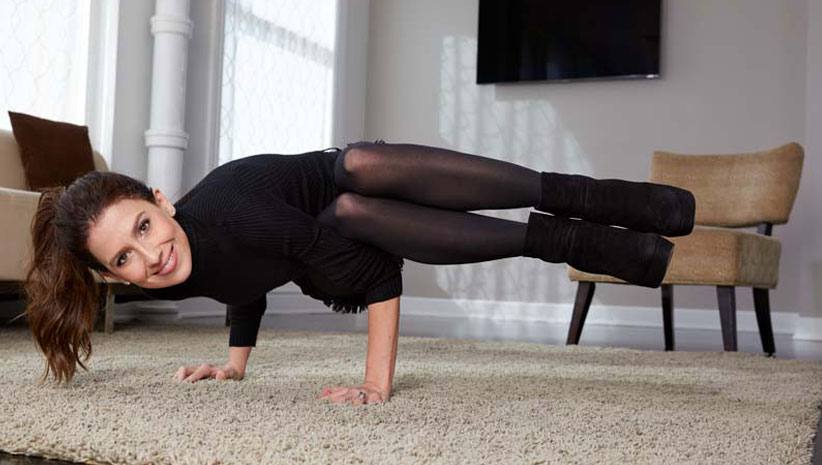
Hilaria Baldwin demonstrating balance in life. Photo by Jeff Skeirk/Rawtographer on location at the Beverly Wilshire.
Hilaria Baldwin knows something about the wobbly art of balance. She grew up between Boston and Spain, enjoying the physicality of gymnastics, flamenco, and Latin ballroom dance; she later danced professionally and taught the art form. Hilaria first discovered yoga while in college at NYU and found it to be a way to reconnect to the ability to listen to herself. Yoga was an antidote to her highly competitive life as a professional dancer and teacher. She dedicated herself to yoga and then became a teacher, focusing on cueing people through a sensation based-practice. In her book, The Living Clearly Method, Hilaria says, “We would use yoga poses to get into the feeling of being in the body, and from that place, to find more awareness, compassion, and room for change. We explored how a physical practice could be a way of feeling into our lives from the inside out and a key to reclaiming our power so we were not ruled by our thoughts, fears, and stories.”
Even with this compassionate, body-centered focus, Hilaria still had some of her own lessons to live and learn. A long struggle with perfectionism and an eating disorder that included anorexia, bulimia, and being 20 pounds underweight, combined with a grueling personal schedule and a nagging hip injury, all led to a broken hip merely weeks before she and her business partner opened their studio, Yoga Vida. Hilaria taught from a wheelchair when the studio opened. This led to her embarking on a process of recovery—physically, mentally, and emotionally. Once her health was stabilized, she clearly proclaimed to the universe and her friends that she was ready to fall in love, find a partner, and start a family. Which she did.
People may know Hilaria Baldwin as the co-founder of NYC studio Yoga Vida (opened in 2009, where she still teaches), from her playful Instagram account, her celeb husband (actor Alec Baldwin) and their three kids, and/or now her new book from Rodale —The Living Clearly Method: 5 Principles for a Fit Body, Healthy Mind & Joyful Life.
Yet as her story suggests, there is more to her lifestyle method than the playful inversions and stilettos in her posts. Since she is someone who has had to learn for herself about the wobbly art of balance, she is gracious and generous when it comes to sharing the practice with others.
Hilaria Baldwin and The Living Clearly Method
As Hilaria says in the The Living Clearly Method, “My journey of living the questions has convinced me that even if we can’t improve every part of our lives, we can become more present to them.” She says this method “starts with listening to yourself and creating a connection through yoga, but that’s just the beginning.”
Her book describes her personal story and then takes the reader through a journey via The Living Clearly Method. The five principles she outlines for the method are: Perspective, Breathing, Grounding, Balance, and Letting Go. When you read the pages, you feel as though you are receiving advice from a wise sister, someone who knows what it is like to stare both joy and heartbreak in the face and then find a way to thrive.
Hilaria Baldwin on Balance
When Hilaria and her family were on a recent trip to Los Angeles, she took some time to talk about balance and to play around with poses and the practice.
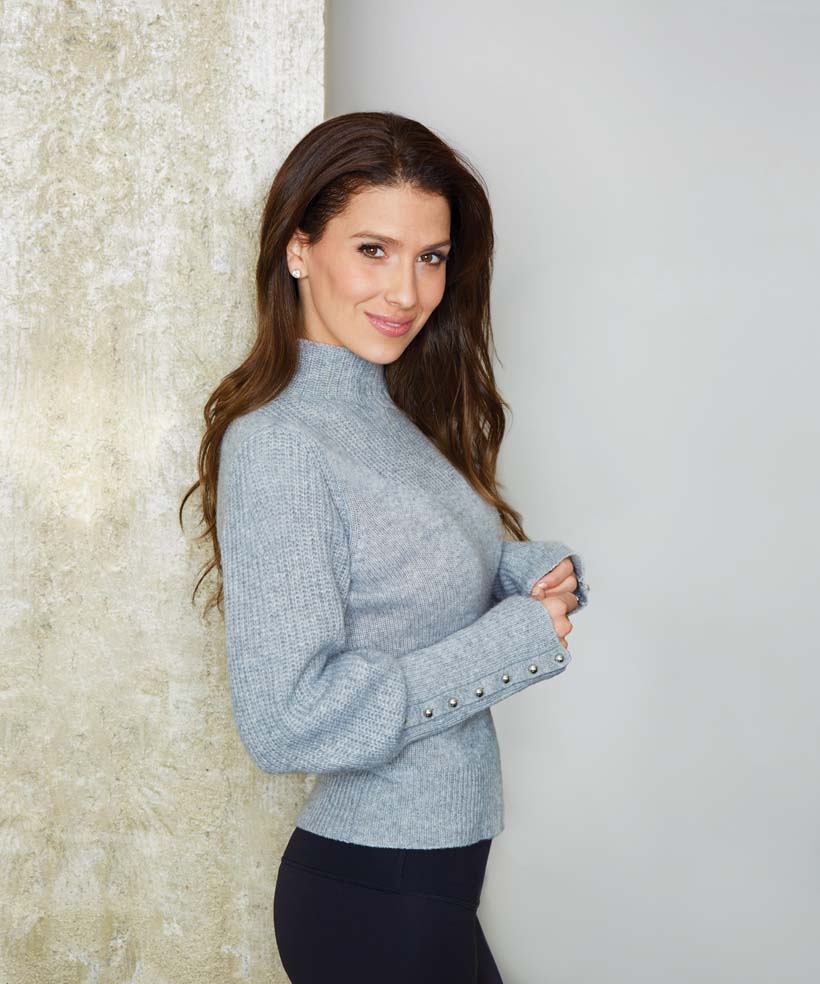
Hilaria Baldwin photographed by Jeff Skeirik/Rawtographer at the Beverly Wilshire, Beverly Hills (A Four Seasons Hotel).
Hilaria Baldwin and her Yoga Practice
LA YOGA: What was meaningful for you about taking up the practice of yoga?
HB: I danced my entire life and I practiced gymnastics. These activities were always things that I was expected to be good at. You had to perform your best, you didn’t just do it for fun or to goof around. This is not to say it wasn’t fun, but there was a purpose of pursuing excellence.
When I started practicing yoga, I was very nervous, just like most people are in their first yoga class. I talk about this a lot with students when they first start. As I continued, I realized there was no expectation of me being particularly good at this. There’s no reason that this has to look a certain way.
It was so liberating, to feel that I could just enjoy myself. Yoga practice is not to impress other people. It was a contrast with dance; yoga is about feeling from the inside out to create the form. It is the feeling that creates the posture, the purpose is the feeling.
Yoga is a practice where it’s all about how it feels and not so much about how it looks, but if you abide by the principles and you practice the yoga, the side effect is that it can be very pretty as well!
In dance, it’s not to say that I didn’t feel great when I danced or got a thrill or a high from performing—that definitely was there too—that was just not the only purpose. I danced through a lot of injuries and it got to the point that I broke my hip, but in yoga that’s a silly thing to do. If you’re injured, you take care of your injury. That was a liberating experience for me.
LA YOGA: What keeps you practicing yoga?
HB: The understanding that I’ll feel really good doing it. I dedicated my life to yoga as a profession because I found it to be brilliant. As much as I like to run and take barre class and do all these things, the brilliance is the yoga postures and the ability to connect body, mind, breath, and movement together. I haven’t found that in any other discipline. It keeps me centered. I can play around and do all sorts of other activities but yoga is what keeps my body healthy and allows me to do other things. Yoga for me needs to be the thing that happens all the time.
LA YOGA: You’re a busy mom and a business woman; how do you continue to maintain your commitment to your practice? What advice would you give to people who are also juggling life and practice?
HB: There are many different kinds of yoga practice. The yoga that I teach and the yoga that I do works well for that Type A personality, the person with that go go go, hectic life. Yoga is finding the calm amidst the storm.
I’m going to pay attention to my children and be the best mom that I can be. I am going to be a good partner for my husband–that’s a given. In addition, I am going to do my job and take care of my students and work and feel like a powerful woman in this age when we are able to be powerful women. I realize that if I don’t do yoga I am not going to be as strong for my children, my husband, or my job.
My yoga practice IS part of what keeps me going and allows me to tumble on the floor with my kids, or teach my students by practicing what I preach, or be there for my husband and be able to stay centered when things feel overwhelming for him.
Now how do I do it in terms of the time frame? I focus on doing yoga as I’m going throughout my day. This is something I talk about in my book, The Living Clearly Method. It is a practice to learn to be so present in your daily life that is is like you’re constantly doing yoga. This includes not just the postures, but the teachings, breathing, awareness—all of these can be practiced in every single moment. My yoga practice includes living my life in this way, aware of what’s happening as it’s happening.
If that means I get to do an hour on the mat a day—great. If that means I only get five minutes—that’s ok too. I feel that I am successful as long as I’m trying to be present and centered and connected in the way that I have learned from my yoga practice. Throughout the rest of the time I feel like I’m doing right by myself and therefore being able to do right by all the people who rely on me.
Hilaria Baldwin’s Advice for Busy Yogis
LA YOGA: That’s great advice. What other advice would you give other working parents (or anyone) who are trying to negotiate these same challenges?
HB: A little goes a long way. Don’t expect perfection from yourself. Sometimes you’re expecting too much—to expect an hour when you’ve got little kids and you’re working and you’re doing all these things—that’s a lot. Say, “Okay I’m going to look at my day, and I’m going to do five minutes in this hour, then I’m going to do five minutes at this time and five minutes at that time,” that can be more manageable. Plan your time, even in small segments.
Practice staying connected to your yoga practice throughout the day. Too often we see people get up from savasana or final relaxation and they leave the room and all of a sudden they re-enter back into madness and disconnection.
The ability to check in multiple times a day can be powerful and can keep you more centered and grounded than practicing for an hour and having the rest of the day be like a complete madhouse.
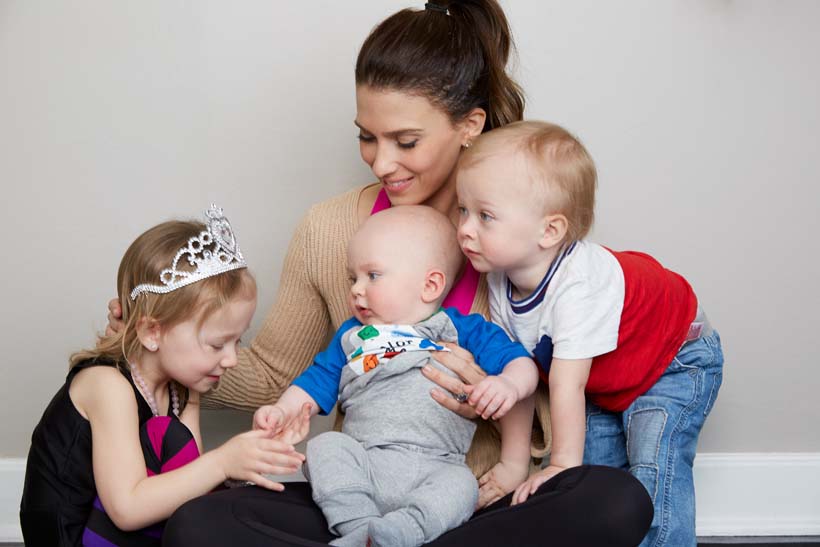
Hilara Baldwin and her kids photographed by Jeff Skeirk/Rawtographer at the Beverly Wilshire, Beverly Hills (A Four Seasons Hotel).
Hilaria Baldwin on Family
I have three kids and there are moments when all my kids are screaming at the same time, or I just can’t hold all three of them at once. When I feel so much tension that I feel like I’m going to explode, I ask myself, well, how can I become calm? How can I understand? At this point, it goes back to my method of gaining perspective. I might ask what’s going on for each one of them right now and have compassion for that. I would ask myself, “Where’s my breath? Am I tightening my breath?” The more you tighten the breath, chances are you’re going to flip out.
I’ll ask, “Where are my feet?” If I find my feet, if I find my grounding and then I know that I’m present, and I’m not going to explode from being overwhelmed and disconnected from my body. I’ll ask “Where’s my balance? Where’s my center? Where’s my core? Where is me?” Everything has to come from me, from my strength. I’ll check in to see if I can release some physical tension. Then I can be more present for my children. Doing that self-care when things get tough, this is when it is most important.
LA YOGA: How do you model this with your kids? Do you encourage them to do yoga with you? What advice would you give to other parents?
HB: Kids become aware of what their parents do. For a while when they would see me standing on my head and practice, they wanted to do it as well. One time, I was trying to explain to my daughter Carmen that people have jobs and I said, “I’m a yoga teacher.” She said, “No, you’re a mommy.” At that time, she didn’t understand that a world outside our relationship exists. Then she got to the point where she wants to be a yoga teacher when she grows up.
Carmen has also gone through phases when I’m practicing in the house, like doing a headstand on a table, and she says, “Mommy get down that’s dangerous.” My son Rafa [Rafael] has a completely different personality and he’ll try to get up there and do it as well.
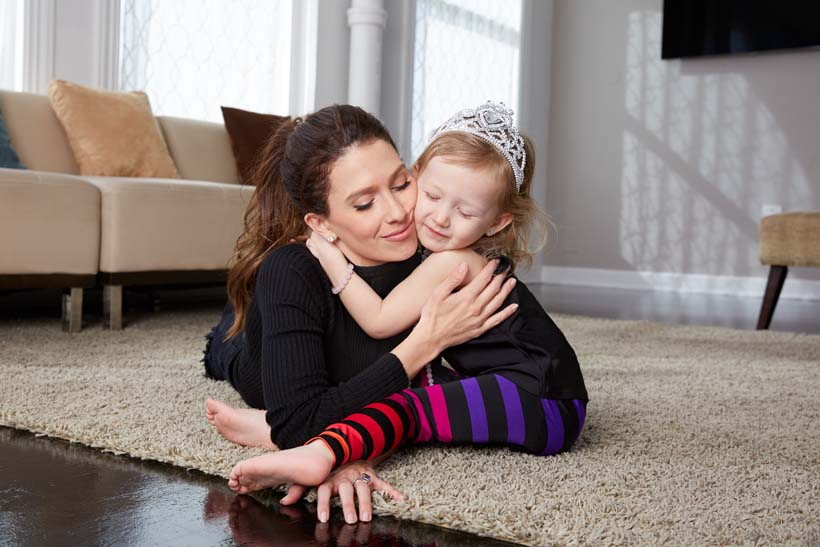
Hilaria Baldwin and Carmen photographed by Jeff Skeirik/Rawtographer at the Beverly Wilshire, Beverly Hills (A Four Seasons Hotel). Carmen is wearing mala and bracelet by Five Star Hippie and kids’ leggings by K-Deer.
I hope that they learn to deal with stressful situations through being grounded and centered as I try to teach them. Of course I’m not perfect. If they’re flipping out about something, I’ll say, “I need you to breathe, just breathe.” We’ll do exercises and sometimes they’ll totally go for it and other times Carmen will say, “I don’t like breathing! I’m never going to breathe again!” I say, “Okay, well let me know how that works for you!” Little by little they start to get it and are able to grasp it. I hope! This is my first time being a parent and I only have three-and-half years experience doing it. I hope that it’s going to serve them well.
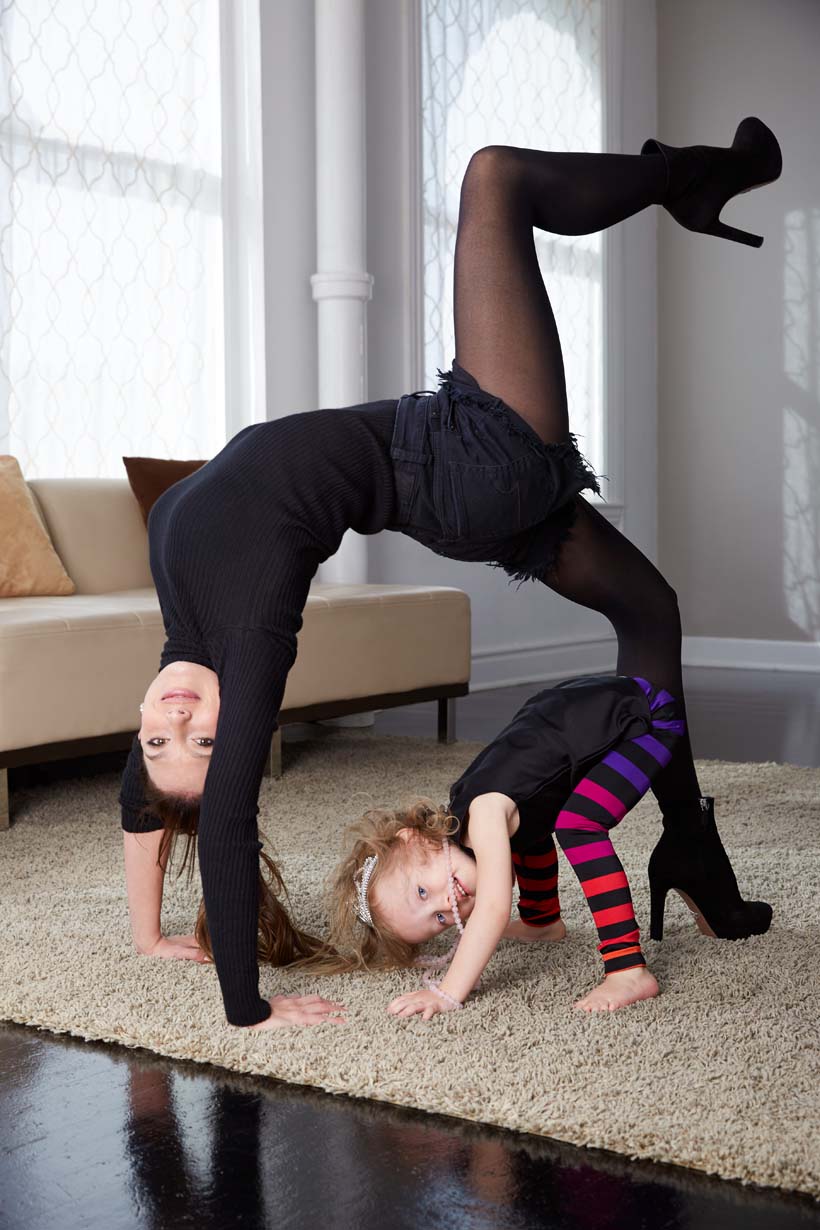
Hillaria Baldwin and her daughter Carmen photographed by Jeff Skeirik/Rawtographer at Beverly Wilshire, Beverly Hills (A Four Seasons Hotel). Carmen is wearing bracelet and mala by Five Star Hippie and kids’ leggings by K-Deer.
Hilaria Baldwin on Balance
LA YOGA: Balance means different things to different people. What does it means to you to live a life of balance, or is that something you even strive for?
HB: For me one part of balance is knowing how to find my center and how everything is related to that center. If we’re doing dancer’s pose, one foot is on the ground. I can ask, “Where is my center relating to my foot? How is the rest of my body pulling and stretching and positioned so that I will not fall over?” If you’re tilted a little bit further forward you have to pull a little bit back and kick a little bit more with the back arm and hand.
How are all these different details and needs in our lives, how are they balanced over our personal center point?
One of the reasons that I love yoga is that these words stem from movement. When I was dealing with my eating disorder and over-exercising and being unhappy, like most people I was capable of saying, “I know it doesn’t make sense that I’m bulimic.” The question was, “Why did I continue to do it?” The answer was that I was disconnected from my body and my body didn’t physically understand balance.
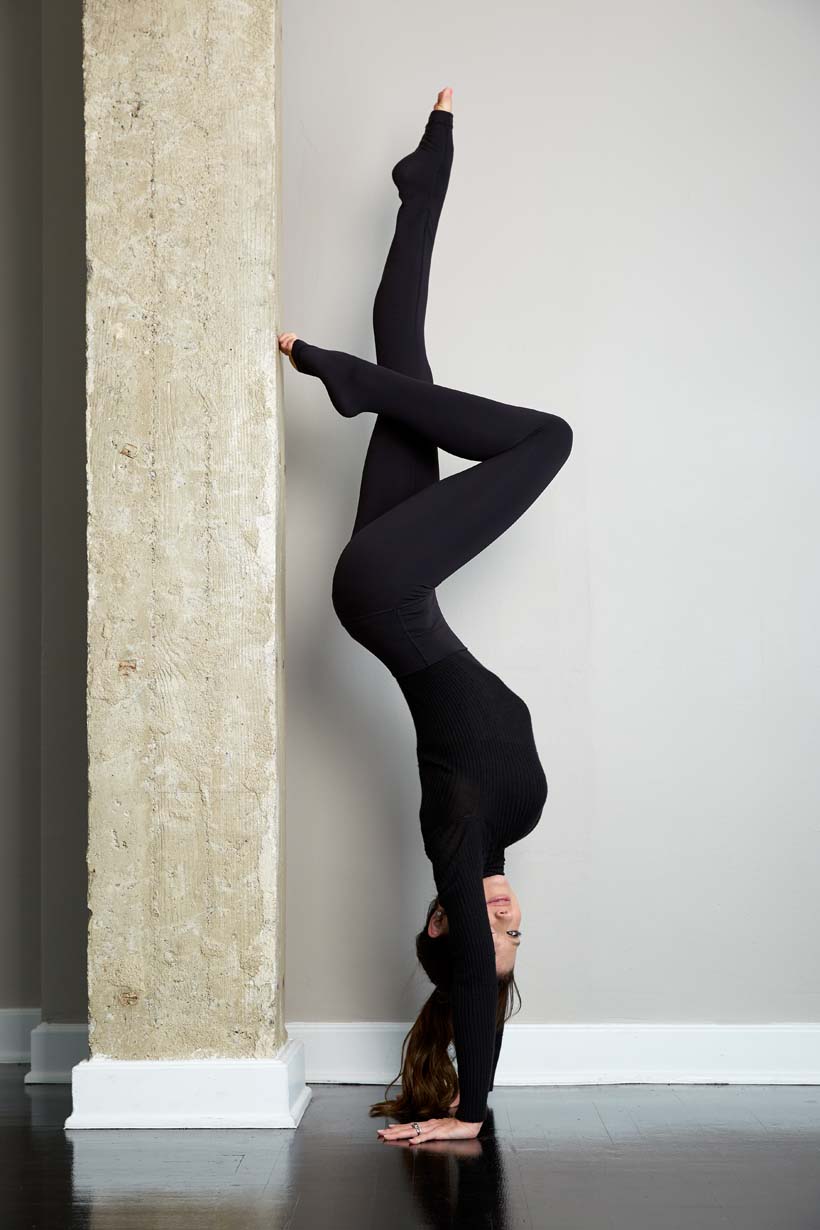
Hilaria Baldwin in handstand variation. Photo by Jeff Skeirik/Rawtographer. Shot on location at the Beverly Wilshire, Beverly Hills (A Four Seasons Hotel).
When it comes to balance, it is significant in every area of life. I ask myself: How do I manage my three children? How do I balance my work and being a strong woman and example of helping people and being able to show that to my children? How do I do that while I meet their needs? Balance can be all these different things. It could be purely the physical yoga practice. It could be individual things like eating, showering, exercising. Balance can also include dynamic with family, it could be work.
For me, it comes back to understanding my personal center point and how all the things around it are relating to the center. That’s why the more you feel your center the more you’re going to be able to find your balance.
One of the most amazing things about yoga is that we balance so often. There are a ton of variations of balancing poses in yoga. My advice to my students is to “Go and be in your body.”
LA YOGA: It’s important to have that connection to the body because that’s what makes the difference between repeating patterns that are not healthy and patterns that are healthy. What have you found to be successful in shifting patterns for students?
HB: Practice is necessary, of course. In addition to practice, we also need curiosity and desire. It is helpful for us to be curious about what else we can experience and harness that drive to learn more. Sometimes people are in savasana and thinking, “Okay I’m done, I’m laying on the floor, I’m in savasana, this is good.” And I say, “Okay if you lay here for five minutes and you focus on all the parts of your body that are touching the floor, with every single inhalation and exhalation they will deepen and increase in number. I promise you are still holding onto things, I promise you are still holding onto tension.” That’s part of it, seeing how far you can go not just in your physical practice but how that relates to the outside world.
The other thing is desire. When I was in the midst of my eating disorder, in order to address it, I had to want it to be different. I’m sure everyone reading this will know someone in their lives that you wish you could help. That’s not ours to be able to fix someone else, a person has to want to do it. We can be there, we can try to give support, we can show by example, we can give options, and we can go with them. But for change to occur there has to be a moment when they say, “I want to be better.”
Whether it’s a big thing like an eating disorder or something like time management, you have to have the desire to make the change. In addition to practice, curiosity and definitely desire are very important.
LA YOGA: What are some things that you find most meaningful about teaching yoga?
HB: I learn just as much from my students as I feel like I teach them. I’m constantly learning, I teach a yoga class and I watch. I find that watching my yoga class as they’re doing it is so important to practice my teaching and to see how they’re getting it. I used to plan my yoga classes and write them down but now it’s like a play that I do with the students. Of course I have certain things that I do, a formula to my class, but then within it I’m watching and seeing what people need.
LA YOGA: In the world that we live in today, people’s stress levels seem to be increasing. What do you find in terms of coming back to the teachings of yoga that is meaningful for you to remedy this?
HB: Learning to stick with your practice in order to feel yourself and the connection that you can have with your physical self is important. We have to be IN ourselves in order to be strong to make a difference. Being connected can also help us practice kindness. I think the world right now needs a lot of kindness and strength. Hate speech has been given a very big microphone and that’s sad.
Stay connected to yourself to create strength, bond with other people, be kind. “Us versus them” is not going to fix anything. These are not sports teams. I think it is a combination of hope, strength, our connection to ourselves, and our practice of kindness that will propel us into a better place.
Hilaria Baldwin Photo Shoot and Story Credits
Photos shot on location at the Beverly Wilshire Hotel: fourseasons.com/beverlywilshire
Photo shoot assistant: Jeannie Jeffries.
Jeff Skeirik can be found at: rawtographer.com
Carmen is wearing mala by fivestarhippie and kids’ leggings by K-Deer.
Learn more about Hilaria Baldwin
For more information about Hilaria Baldwin, visit her studio: YogaVida.com or follow her on social media via Twitter and Instagram@hilariabaldwin
Felicia Tomasko has spent more of her life practicing Yoga and Ayurveda than not. She first became introduced to the teachings through the writings of the Transcendentalists, through meditation, and using asana to cross-train for her practice of cross-country running. Between beginning her commitment to Yoga and Ayurveda and today, she earned degrees in environmental biology and anthropology and nursing, and certifications in the practice and teaching of yoga, yoga therapy, and Ayurveda while working in fields including cognitive neuroscience and plant biochemistry. Her commitment to writing is at least as long as her commitment to yoga. Working on everything related to the written word from newspapers to magazines to websites to books, Felicia has been writing and editing professionally since college. In order to feel like a teenager again, Felicia has pulled out her running shoes for regular interval sessions throughout Southern California. Since the very first issue of LA YOGA, Felicia has been part of the team and the growth and development of the Bliss Network.
